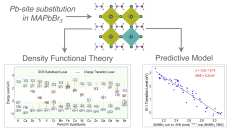Machine-Learned Impurity Level Prediction in Semiconductors

Impurities at the Pbsite were modeled in a hybrid perovskite material, Methylammonium Lead Bromide, and highthroughput DFT computations were launched on NERSC to calculate their formation enthalpies and energy levels. The computed DFT data has been shown for period IV substituents, and a machine learned model has been shown for one impurity level.
Science Achievement
Argonne National Laboratory (ANL) researchers ran high-throughout atomistic simulations on NERSC supercomputers and generated comprehensive computational datasets of impurity properties in two classes of semiconductors: lead-based hybrid perovskites and Cd-based chalcogenides. These datasets led to machine learned models that accelerate prediction and design for the entire chemical space of materials and impurities in these semiconductor classes.
Impact
Impurity energy levels in semiconductors can change their optoelectronic behavior, which has important consequences for solar cell applications. The ability to instantly and accurately estimate such impurity levels is paramount, and the current research combines computational data and machine learning to facilitate that. The models thus developed can potentially transform the design of novel semiconductors that are defect-tolerant or have tailored impurity properties.
Research Details
The researchers performed density functional theory (DFT) calculations for hundreds of impurity atoms in selected semiconductors to determine their formation enthalpies and energy levels. The generated data was transformed into predictive models using nonlinear regression-based machine learning algorithms. The DFT simulations modeled systems containing ~ 100 atoms over several months, using ~ 1,500,000 CPU hours on NERSC.
"NERSC was absolutely instrumental in the progress of our research, which has resulted in first of their kind computational databases and machine learning models. Support at NERSC was always prompt in terms of providing user access to the required versions and executables of VASP, and answering other important queries. NERSC workshops, manuals and newsletters on HPC and deep learning related issues were extremely useful for the current research," said Arun Kumar Mannodi Kanakkithodi from Argonne National Laboratory.
Related Links
- Mannodi-Kanakkithodi, Arun; Park, Ji-Sang; Jeon, Nari; Cao,Duyen H.; Gosztola, David J.; Martinson, Alex B. F.; Chan,Maria K. Y., "Comprehensive Computational Study of Partial Lead Substitution in Methylammonium Lead Bromide"; CHEMISTRY OF MATERIALS, 31:3599-3612; 2019 MAY 28, 10.1021/acs.chemmater.8b04017
- Cao, Duyen H.; Guo, Peijun; Mannodi-Kanakkithodi, Arun; Wiederrecht, Gary P.; Gosztola, David J.; Jeon, Nari; Schaller,Richard D.; Chan, Maria K. Y.; Martinson, Alex B. F., "Charge Transfer Dynamics of Phase-Segregated Halide Perovskites: CH3NH3PbCl3 and CH3NH3PbI3 or (C4H9NH3)(2)(CH3NH3)(n-1)Pb(n)I(3n+1)Mixtures"; ACS APPLIED MATERIALS & INTERFACES, 11:9583-9593; 2019 MAR 6, 10.1021/acsami.8b20928
About NERSC and Berkeley Lab
The National Energy Research Scientific Computing Center (NERSC) is a U.S. Department of Energy Office of Science User Facility that serves as the primary high performance computing center for scientific research sponsored by the Office of Science. Located at Lawrence Berkeley National Laboratory, NERSC serves almost 10,000 scientists at national laboratories and universities researching a wide range of problems in climate, fusion energy, materials science, physics, chemistry, computational biology, and other disciplines. Berkeley Lab is a DOE national laboratory located in Berkeley, California. It conducts unclassified scientific research and is managed by the University of California for the U.S. Department of Energy. »Learn more about computing sciences at Berkeley Lab.







